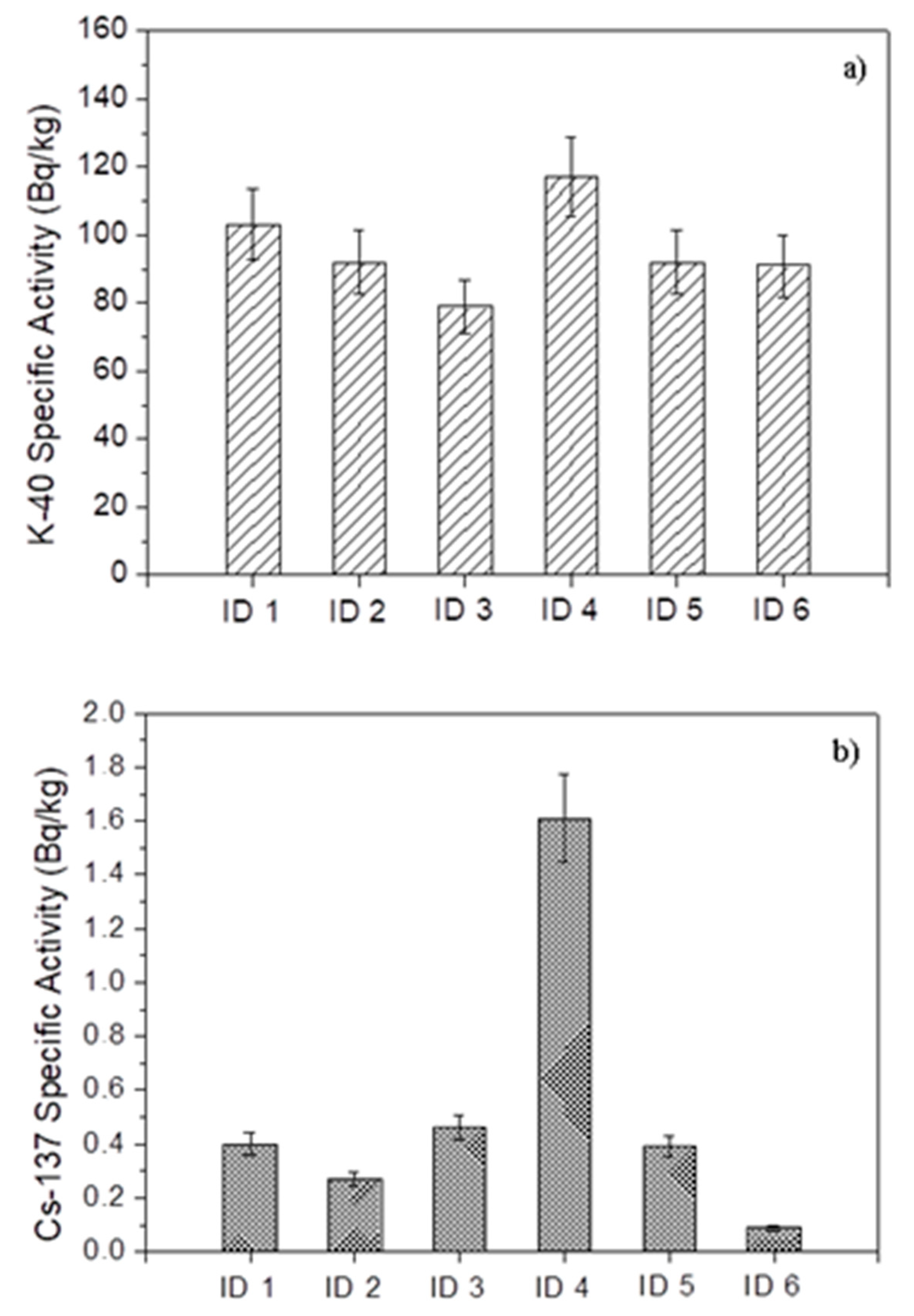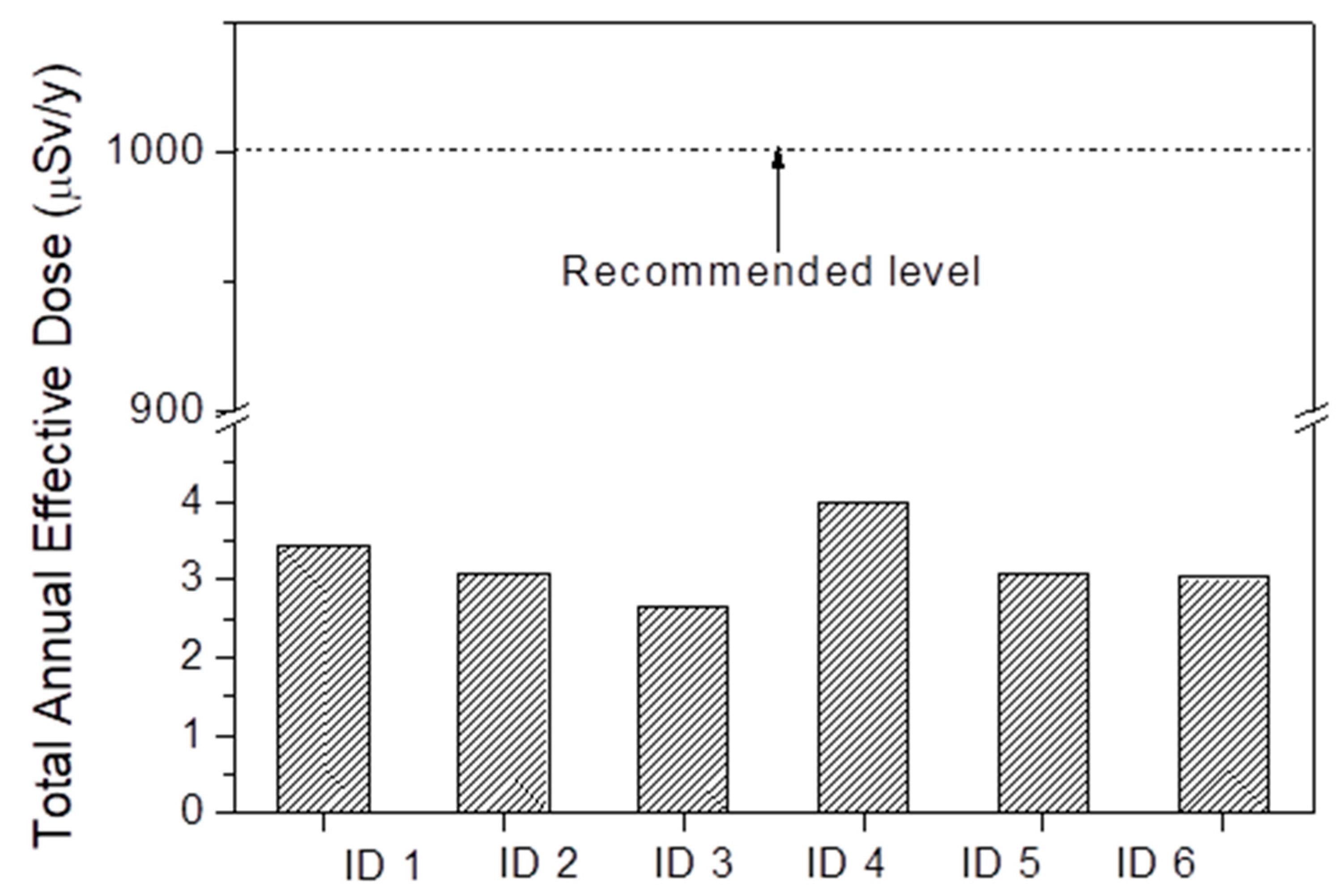Radioactivity in Calabrian (Southern Italy) Wild Boar Meat
Abstract
:1. Introduction
2. Materials and Methods
3. Results and Discussion
4. Conclusions
Author Contributions
Funding
Acknowledgments
Conflicts of Interest
References
- Massei, G.; Kindberg, J.; Licoppe, A.; Gačić, D.; Šprem, N.; Kamler, J.; Baubet, E.; Hohmann, U.; Monaco, A.; Ozoliņš, J.; et al. Wild boar populations up, numbers of hunters down? A review of trends and implications for Europe. Pest Manag. Sci. 2015, 71, 492–500. [Google Scholar] [CrossRef] [PubMed]
- Ruiz-Fons, F.; Segales, J.; Gortazar, C.A. A review of viral diseases of the European wild boar: Effects of population dynamics and reservoir role. Vet. J. 2008, 176, 158–169. [Google Scholar] [CrossRef] [PubMed]
- Caridi, F.; Marguccio, S.; Belvedere, A.; D’Agostino, M.; Belmusto, G. The natural radioactivity in food: A comparison between different feeding regimes. Curr. Nutr. Food Sci. 2019, 15, 493–499. [Google Scholar] [CrossRef]
- Mirceta, J.; Petrovic, J.; Malesevic, M.; Blagojevic, B.; Antic, D. Assessment of microbial carcass contamination of hunted wild boars. Eur. J. Wildl. Res. 2017, 63, 37. [Google Scholar] [CrossRef] [Green Version]
- European Food Safety Authority (EFSA). Scientific opinion on the public health hazards to be covered by inspection of meat from farmed game. EFSA J. 2013, 11, 32641–32681. [Google Scholar]
- Caridi, F.; D’Agostino, M.; Messina, M.; Marcianò, G.; Grioli, L.; Belvedere, A.; Marguccio, S.; Belmusto, G. Lichens as environmental risk detectors. Eur. Phys. J. Plus 2017, 132, 189. [Google Scholar] [CrossRef]
- Caridi, F.; Belvedere, A.; D’Agostino, M.; Marguccio, S. 137Cs activity concentration in mosses in the Calabria region, south of Italy. J. Instrum. 2017, 12, P05001. [Google Scholar] [CrossRef]
- Kocadag, M.; Exler, V.; Burger-Scheidlin, C.; Baumgartner, A.; Stietka, M.; Landstetter, C.; Korner, M.; Maringer, F.J. Environmental radioactivity study of Austrian and Bavarian forest ecosystems: Long-term behavior of contamination of soil, vegetation and wild boar and its radioecological coherences. Appl. Radiat. Isot. 2017, 126, 106–111. [Google Scholar] [CrossRef] [PubMed]
- Skuterud, L.; Travnikova, I.G.; Balonov, M.I.; Strand, P.; Howard, B.J. Contribution of fungi to radiocaesium intake by rural populations in Russia. Sci. Total Environ. 1997, 193, 237–242. [Google Scholar] [CrossRef]
- Available online: https://www.ortec-online.com/products/radiation-detectors/germanium-hpge-radiationdetectors/detector-cooling/mobius (accessed on 23 January 2020).
- Caridi, F.; D’Agostino, M.; Belvedere, A.; Marguccio, S.; Belmusto, G. Radon radioactivity in groundwater from the Calabria region, south of Italy. J. Instrum. 2016, 11, P05012. [Google Scholar] [CrossRef]
- Available online: http://store.uni.com/catalogo/uni-11665-2017?josso_back_to=http://store.uni.com/josso-security-check.php&josso_cmd=login_optional&josso_partnerapp_host=store.uni.com (accessed on 23 January 2020).
- Caridi, F.; D’Agostino, M.; Marguccio, S.; Belvedere, A.; Belmusto, G.; Marcianò, G.; Sabatino, G.; Mottese, A. Radioactivity, granulometric and elemental analysis of river sediments samples from the coast of Calabria, south of Italy. Eur. Phys. J. Plus 2016, 131, 136. [Google Scholar] [CrossRef]
- Caridi, F.; Marguccio, S.; D’Agostino, M.; Belvedere, A.; Belmusto, G. Natural radioactivity and metal contamination of river sediments in the Calabria region, south of Italy. Eur. Phys. J. Plus 2016, 131, 155. [Google Scholar] [CrossRef]
- Italian Legislative Decree 230/95 and Successful Modifications and Integrations. Available online: www.normattiva.it (accessed on 16 January 2020).
- United Nations Scientific Committee on the Effects of Atomic Radiation (UNSCEAR). UNSCEAR 2000 Report to the General Assembly, with Scientific Annexes; UNSCEAR: New York, NY, USA, 2000. [Google Scholar]
- Mietelski, J.W.; Jasinska, M.; Kozak, K.; Ochab, E. The method of measurement used in the investigation of radioactive contamination of forests in Poland. Appl. Radiat. Isot. 1996, 47, 1089–1095. [Google Scholar] [CrossRef]
- The Radioactivity Database of the “Italian Institute for the Environmental Protection and Research” (ISPRA). Available online: www.radia.apat.it (accessed on 28 January 2020).
- Italian Health Ministry, Food Safety Section, Opinion N. 8 2017. Available online: www.salute.gov.it (accessed on 28 January 2020).
- ICRP. Compendium of Dose Coefficients Based on ICRP Publication 60. ICRP Publication 119. Ann. ICRP 2012, 41, 1–130. [Google Scholar] [CrossRef] [PubMed] [Green Version]
- Hachinoe, M.; Fujimoto, R.; Shinano, T.; Kotake-Nara, E.; Hamamatsu, S.; Kawamoto, S. Reduction in the radiocaesium in meats of the sika deer and wild boar by cooking. J. Food Prot. 2020, 83, 467–475. [Google Scholar] [CrossRef] [PubMed]



| Sampling Point | GPS Coordinates |
|---|---|
| ID1 | 38° 15′49″ N |
| 15° 52′40″ E | |
| ID2 | 38° 02′59″ N |
| 15° 41′04″ E | |
| ID3 | 38° 29′03″ N |
| 15° 52′40″ E | |
| ID4 | 38° 18′01″ N |
| 16° 04′57″ E | |
| ID5 | 38° 21′01″ N |
| 16° 04′05″ E | |
| ID6 | 38° 22′51″ N |
| 16° 24′31″ E |
| Sampling Point | K-40 (Bq kg−1) | Cs-137 (Bq kg−1) | Sampling Point | K-40 (Bq kg−1) | Cs-137 (Bq kg−1) | Sampling Point | K-40 (Bq kg−1) | Cs-137 (Bq kg−1) |
|---|---|---|---|---|---|---|---|---|
| ID1 | 110 ± 9 | 0.37 ± 0.10 | ID3 | 70 ± 6 | 0.62 ± 0.15 | ID5 | 80 ± 11 | 1.12 ± 0.19 |
| 113 ± 9 | 0.51 ± 0.09 | 63 ± 6 | 1.28 ± 0.18 | 93 ± 12 | 0.30 ± 0.10 | |||
| 97 ± 5 | 0.29 ± 0.08 | 83 ± 11 | 0.06 ± 0.02 | 80 ± 12 | 0.07 ± 0.02 | |||
| 104 ± 6 | 0.61 ± 0.22 | 107 ± 10 | 0.25 ± 0.06 | 113 ± 15 | 0.08 ± 0.03 | |||
| 95 ± 12 | 0.25 ± 0.07 | 70 ± 5 | 0.11 ± 0.03 | 92 ± 13 | 0.41 ± 0.09 | |||
| Mean value | 103 ± 8 | 0.40 ± 0.13 | Mean value | 79 ± 9 | 0.46 ± 0.09 | Mean value | 92 ± 13 | 0.39 ± 0.09 |
| ID2 | 153 ± 21 | 0.24 ± 0.08 | ID4 | 96 ± 7 | 1.87 ± 0.23 | ID6 | 102 ± 13 | 0.08 ± 0.03 |
| 71 ± 10 | 0.45 ± 0.13 | 118 ± 16 | 0.79 ± 0.18 | 80 ± 11 | 0.09 ± 0.03 | |||
| 75 ± 6 | 0.26 ± 0.06 | 135 ± 18 | 2.14 ± 0.32 | 95 ± 12 | 0.11 ± 0.04 | |||
| 66 ± 6 | 0.13 ± 0.04 | 119 ± 16 | 1.41 ± 0.25 | 85 ± 11 | 0.07 ± 0.03 | |||
| 93 ±12 | 0.26 ± 0.08 | 115 ± 15 | 1.83 ± 0.23 | 91 ± 12 | 0.12 ± 0.04 | |||
| Mean value | 92 ± 11 | 0.27 ± 0.08 | Mean value | 117 ± 14 | 1.61 ± 0.24 | Mean value | 91 ± 11 | 0.09 ± 0.03 |
| Sampling Point | Ek-40 (µSv a−1) | ECs-137 (µSv a−1) | Etot (µSv a−1) |
|---|---|---|---|
| ID1 | 3.42 | 0.03 | 3.45 |
| ID2 | 3.06 | 0.02 | 3.08 |
| ID3 | 2.63 | 0.03 | 2.66 |
| ID4 | 3.89 | 0.11 | 4.00 |
| ID5 | 3.06 | 0.03 | 3.09 |
| ID6 | 3.02 | 0.01 | 3.03 |
© 2020 by the authors. Licensee MDPI, Basel, Switzerland. This article is an open access article distributed under the terms and conditions of the Creative Commons Attribution (CC BY) license (http://creativecommons.org/licenses/by/4.0/).
Share and Cite
Caridi, F.; D’Agostino, M.; Belvedere, A. Radioactivity in Calabrian (Southern Italy) Wild Boar Meat. Appl. Sci. 2020, 10, 3580. https://doi.org/10.3390/app10103580
Caridi F, D’Agostino M, Belvedere A. Radioactivity in Calabrian (Southern Italy) Wild Boar Meat. Applied Sciences. 2020; 10(10):3580. https://doi.org/10.3390/app10103580
Chicago/Turabian StyleCaridi, Francesco, Maurizio D’Agostino, and Alberto Belvedere. 2020. "Radioactivity in Calabrian (Southern Italy) Wild Boar Meat" Applied Sciences 10, no. 10: 3580. https://doi.org/10.3390/app10103580








